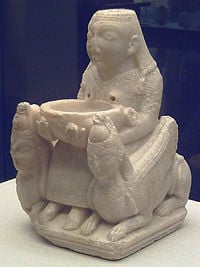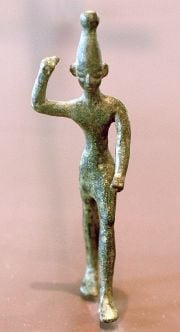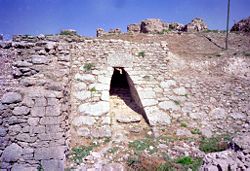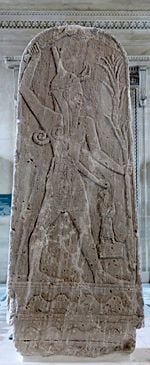Canaanite Religion
Canaanite religion describes belief systems and ritual practices of the people living in the ancient Levant throughout the Bronze Age and Iron Age. Until recently, little was known of these tradition outside of the Hebrew Bible, which denigrated them as idolatrous and licentious. Twentieth century archaeological excavations, however, unearthed several texts which provided previously unknown details and insights into the nature of Canaanite religion.
Although the sources are still scarce, the Canaanite religion seems to have involved a rich mythological tradition which served as a bridge between the more ancient Mesopotamian religions and the later Greek and Roman gods. Several of the most famous Greek gods, for example, clearly evolved from Canaanite antecedents, just as several of the Canaanite gods grew out of Mesopotamian roots.
Like other ancient cultures, Canaanite society was largely concerned with agricultural themes. As a dryer land than either Egypt or the Fertile Crescent, rain gods—more than river or moon deities—came to fore. The supreme deity of the Canaanite pantheon was El, together with his consort Asherah. As with the Greek tradition, these early gods were later supplanted by younger, more immediate presences such as the rain/thunder god Ba'al and his consorts, such as the warrior goddess Anat and the love/fertility goddess Astarte. Early Israelite religion may once have shared the Canaanite belief in El and other gods, before the monotheistic tradition emerged.
History
Until the excavation of Canaanite Ras Shamra—the site historically known as Ugarit)—and the discovery of its Bronze Age archive of clay tablet alphabetic cuneiform texts, little was known of Canaanite religion except for accounts in the Hebrew Bible. Papyrus seems to have been the preferred writing medium, and unlike Egypt, in the humid Mediterranean climate, these documents have simply decayed. The accounts of the Bible regarding Canaanite religion were highly biased and uniformly negative. A few secondary and tertiary Greek sources included (Lucian of Samosata's De Syria Dea (The Syrian Goddess), fragments of the Phoenician History of Philo of Byblos quoting Sanchuniathon of Berythus (Beirut), and the writings of Damasacius). More recently, the detailed study of the Ugaritic material—together with inscriptions from the Ebla archive at Tel Mardikh and various other achaeological finds—have cast more light on the early Canaanite religion.
Canaanite mythology was strongly influenced by Mesopotamian and Egyptian traditions. At the same time, Egypt appears to have inherited certain religious traditions from the Canaanites as well. Canaanite religious beliefs were polytheistic, with families typically focusing worship on ancestral household gods and goddesses while honoring major deities such as El, Ashera, Baal, Anat and Astarte. Kings also played an important religious role especially in certain ceremonies, such as the sacred marriage of the New Year Festival, and may have been revered as gods.
Pantheon of Canaanite religion
The Canaanite pantheon was conceived as a divine clan, headed by the supreme god El; the gods collectively made up the elohim. Through the centuries, the pantheon of Canaanite gods evolved, so that El and Asherah were more important in earlier times, while Baal and his consorts came to fore in later years. Many of the Canaanite deities found their way into the Greek and Roman pantheon. For example, the characteristics of both El and Baal may be seen in Zeus, while Anat is similar to Athena. Some of the deities listed below are mentioned only briefly in the Canaanite texts, while others were important locally or nationally—such as Chemosh—but perhaps not throughout the region. Still others, such a Moloch, are known mainly from Hebrew texts.

- Anat—virgin goddess of war and fertility, honored as a protector, agent of vengeance, and bearer of life.
- Asherah—early semitic Mother Goddess, walker of the sea, consort of El, also called Athirat, the mother of 70 gods
- Astarte—goddess of love and fertility, sometimes portrayed as the consort of Baal/Hadad
- Baalat or Baalit—the chief deity of Byblos, also identified with Astarte and Aphrodite
- Ba'al—meaning "Lord," god of rain, thunder, and fertility, sometimes synonymous Hadad; also used as a title prefixing the names of local deities
- Baal-Hammon, god of fertility and renewal in the Phoenician colonies of the Western Mediterranean
- Chemosh—the national god of Moab, referred to in both Moabite and Hebrew texts.
- Dagon—god of crop fertility
- El—the chief god, also worshiped by the Israelites
- El Elyon—Special title of El as "God most High"
- Eshmun—Phoenician god of healing
- Kathirat—a group of goddesses appearing in the Ugartic texts as divine midwives
- Kothar—full name Kothar-wa-Khasis, the skilled, clever god of craftsmanship
- Lotan—he seven-headed sea serpent or dragon, the pet of Yam or Yam's alter ego, related to the biblical Leviathan
- Melqart—the god who is King of the city, the underworld and cycle of vegetation in Tyre
- Moloch—title for the god who is "king," probably identical with Milcom and known mainly from the Hebrew Bible as the deity to whom child sacrifices were offered
- Mot—God of sterility, death, and the waterless desert
- Nikkal—goddess of fruit and orchards, married to Yarikh
- Qadeshtu—the Holy One, goddess of love
- Resheph—God of plague and healing
- Shalim and Shachar—twin gods of dusk and dawn
- Shamayim—the god of the sky or the heavens.
- Shemesh—Mesopotamian god of the sun also worshiped in Canaan; his name means "sun" in Hebrew and may be related that of the hero Samson
- Tanit—Phoenician lunar goddess, worshiped as the patron goddess at Carthage, and sometimes identified with Astarte or Anat
- Yam—god of the sea
- Yarikh—god of the moon, after whom the city of Jericho was named; Lord of the sickle, provider of nightly dew; married to the goddess Nikkal
- Zadok
Cosmology
In Ugarit, the gods were call as 'ilhm (elohim) or the children of El, a probable parallel to the the biblical "sons of God"). The chief god an progenitor of the universe was El, also known as Elion (biblical El Elyon), who was the father of the divinities. In the Urgaritic material El is the consort of Ashera, who is described as the "mother of 70 gods."
In the Urgaritic Baal cycle, Baal earns his position as the champion and ruler of the gods by defeated the tyrannical Yam, who has been placed over the other gods by El. Asherah offers herself as a sacrifice if Yam will ease his grip on her children. He agrees, but Baal boldly declares he will defeat Yam. With the aid of magical weapons given to him by the divine craftsman Kothar-wa-Khasis, Baal is victorious. However, the god of death and the underworld, Mot, soon lures Baal to his death in the desert, spelling ruin for the land. Baal's sister/wife Anat retrieves his body and assaults Mot, ripping him to pieces and scattering his remains like over the fields. El, meanwhile, has had a dream suggesting that Baal would be resurrected, which indeed takes place. However, Mot, too, had revived and mounted a new attack against Baal. After their titanic but indecisive battle, Mot finally bows before Baal, leaving Baal in possession of the land and the undisputed regent of the gods.
Thus, Baal came to replace El as the most important deity, although El himself remained theoretically supreme. In practice, temples to Baal were fairly common in Canaanite culture, and many ritual objects devoted to Astarte and Anat have also been uncovered. Even Israelites honored Baal and the "asherim," the latter term referring to poles, standing stones, and even trees probably devoted to a goddess and accompanying altars to both Baal and Yaweh/El.
In the Greek sources describing Canaanite religion, the union of El Elyon and his consort bore Uranus and Ge, Greek names for the "Heaven" and the "Earth." Biblical scholars see a parallel between this and the opening verse of Genesis 1:1 "In the beginning Elohim created to the Heaven and the Earth." A further parallel is seen with the story of the Babylonian creation myths.
The Greek sources also describe El as married to Beruth (Beirut = the city). This marriage of the divinity with the city seems to have biblical parallels with the stories of the link between Melkart and Tyre, Yahweh and Jerusalem, Chemosh and Moab, and both Tanit and Baal Hammon with Carthage. El Elyon is called "God Most High" in Genesis 14.18–19 as the God whose priest was Melchizedek king of Salem. Psalm 78:35 appears to identify El Elyon and the Hebrew God, Elohim, also call Yahweh (the Lord).
Relationship to biblical religion
Although the biblical writers cast Canaanite religion as the antithesis of Israelite monotheism, historians of religion tend to view the early Israelite religion as largely evolving out of Canaanite culture, of which it was once part. The Book of Genesis itself describes the patriarch Abraham as a worshiper of El—also called El Shaddai and El Elyon—building altars, offering sacrifices, and paying tithes to him. Exodus indicates that the Hebrews knew God only as El Shaddai until the time of Moses, who learned God's true name, Yahweh (the Lord), at Mount Sinai: "I appeared to Abraham, to Isaac and to Jacob as God Almighty (El Shaddai), but by my name the Lord I did not make myself known to them." (Exodus 6:3)
Certain passages in the Bible, considered to be the more ancient verses by critical scholars, imply that Israelite religion was once polytheistic. For example, Deuteronomy 32:8-9 indicates a moment when El Elyon assigned Israel to Yahweh, and other nations to various other deities:
When the Most High (Elyōn) divided to the nations their inheritance, he separated the sons of man... the Lord's portion is his people, Jacob his allotted inheritance.
Similarly, Psalm 82:1-6 says that "God (Elohim) presides in the great assembly; he gives judgment among the gods... I said, 'You are gods; you are all sons of the Most High (Elyon).' But you will die like mere men; you will fall like every other ruler."
What may be described in these verses is a process of El and Yahweh merging into the one supreme God and then reducing the other Canaanite deities into something less than gods altogether. Indeed, some versions of Psalm 82 render the word "gods" as "heavenly beings" or even "angels." Similarly, Job 1:6 states that "One day the sons of God (also sometimes translated as "angels") came to present themselves before the Lord, and Satan also came with them."
According to many historians of religion, the angels of later Jewish mythology where once members of the divine assembly consisting of El and the ben-elohim, (sons of God), who were originally the lesser deities described in the Canaanite pantheon. Indeed, such a divine assembly appears several times in the Canaanite texts.
The Hebrew prophets not only denounced Canaanite religion for its polytheism and idolatry but also for its sexual immorality and practice of human sacrifice. That the Canaanites practiced the rite of hieros gamos, involving ritual sex between the king or priest representing a god and a woman or priestess representing a goddess, seems well attested—even if it was not as common at the prophets claimed. The practice of human sacrifice also seems to have occurred among the Canaanites, as it once did among the Israelites in the case of Jephthah's daughter, for example. In the time of Jeremiah, Israelites still offered the children as sacrifice, a practice apparently intended to satisfy Yahweh, who says through the prophet that he never commanded such a thing, "nor did it ever enter my mind." Jeremiah similarly denounces the common practice of Israelite families of offering honey cakes to the Queen of Heaven—probably Astarte or Anat by this time, rather than Asherah. Archaelogical evidence also supports the fact that not only Canaanites by Israelites as well kept figurines of goddesses in their homes at least until the time of the Babylonian exile.
Whether one sees Israelite religion as growing out of Canaanite religion or being perverted by it, the reality seems to be that Israelite religion did not completely separate from its Canaanite counterpart until the return of the Jews from Babylon or later.
ReferencesISBN links support NWE through referral fees
- Cross, Frank Moore. Canaanite Myth and Hebrew Epic, Harvard University Press, 1973. ISBN 9780674091764
- Day, John. Yahweh & the Gods & Goddesses of Canaan, Sheffield Academic Press, 2000. ISBN 1850759863
- Dever, William G., Did God Have A Wife? Archeology And Folk Religion In Ancient Israel. William. B. Eerdmans Publishing Company, 2005. ISBN 0802828523
- Finkelstein, Israel, The Bible Unearthed: Archeology's New Vision of Ancient Israel and the Origin of Its Sacred Texts. New York: Free Press, 2002. ISBN 0684869128
- Gibson, J. C. L. Canaanite Myths and Legends, T. & T. Clark. 2000. ISBN 0567023516
- Hadley, Judith M., The Cult of Asherah in Ancient Israel and Judaism. University of Cambridge 2000. ISBN 0521662354
- Kapelrud, Arvid Schou. The Violent Goddess: Anat in the Ras Shamra texts, Oslo: University Press, 1969. ASIN B000JJK24G
- Patai, Raphael. The Hebrew Goddess. Wayne State University Press; 3rd edition. 1990. ISBN 9780814322710
- Smith, Mark S. The Origins of Biblical Monotheism: Israel's Polytheistic Background and the Ugaritic Texts. Oxford University Press, paperback edition, 2003. ISBN 0195167686
- Wyatt, N. Religious Texts from Ugarit, Sheffield Academic Press, 2 Revised edition, 2003. ISBN 9780826460486
Credits
New World Encyclopedia writers and editors rewrote and completed the Wikipedia article in accordance with New World Encyclopedia standards. This article abides by terms of the Creative Commons CC-by-sa 3.0 License (CC-by-sa), which may be used and disseminated with proper attribution. Credit is due under the terms of this license that can reference both the New World Encyclopedia contributors and the selfless volunteer contributors of the Wikimedia Foundation. To cite this article click here for a list of acceptable citing formats.The history of earlier contributions by wikipedians is accessible to researchers here:
The history of this article since it was imported to New World Encyclopedia:
Note: Some restrictions may apply to use of individual images which are separately licensed.


